Gastroesophageal Reflux Disease Market Size
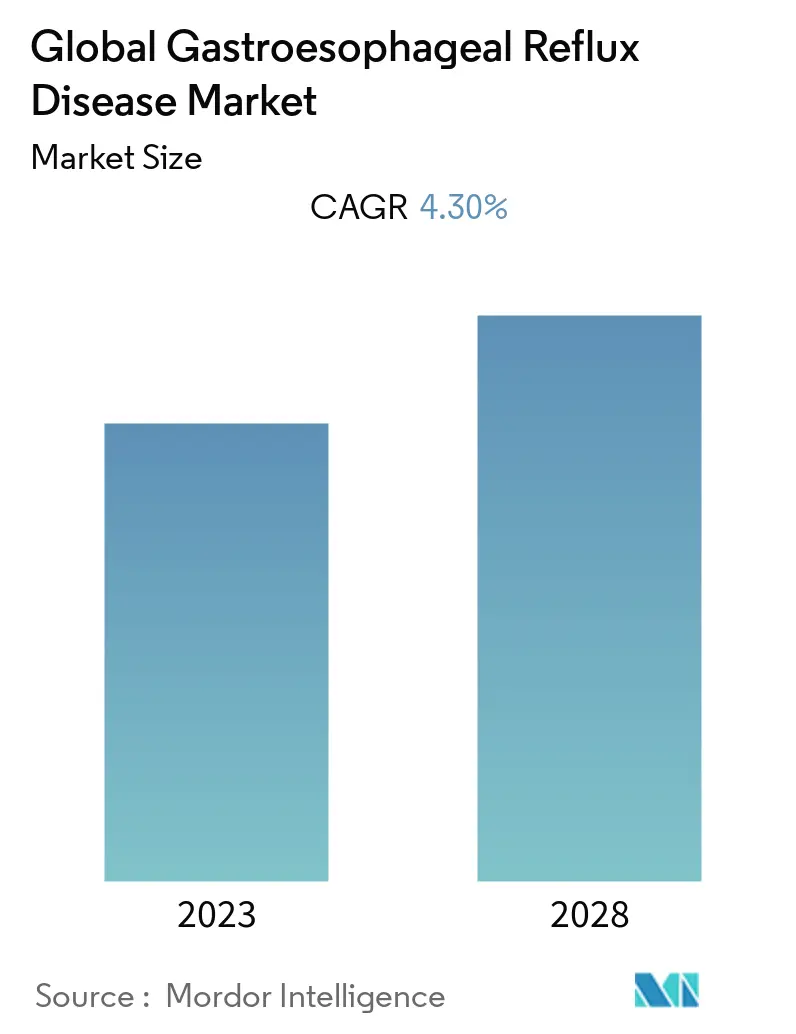
| Study Period | 2018 - 2028 |
| Base Year For Estimation | 2021 |
| Forecast Data Period | 2024 - 2028 |
| CAGR | 4.30 % |
| Fastest Growing Market | Asia Pacific |
| Largest Market | North America |
Major Players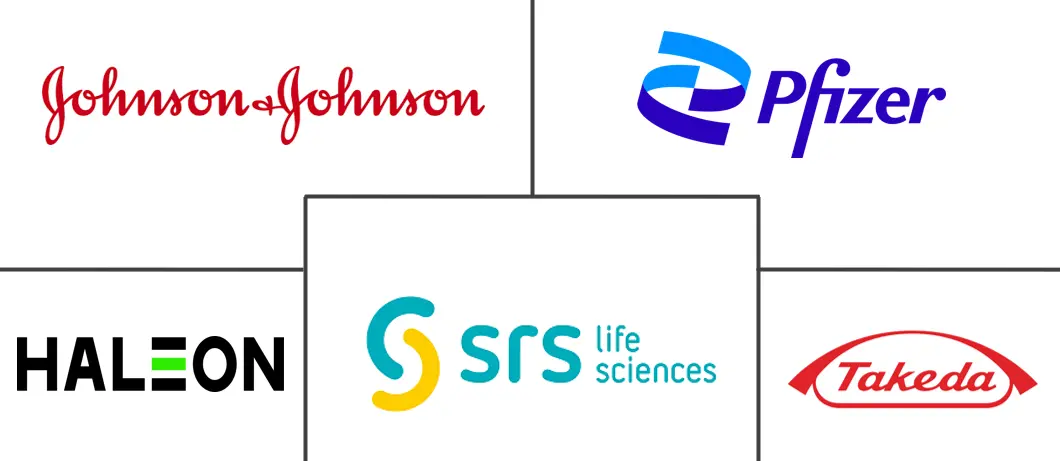
*Disclaimer: Major Players sorted in no particular order |
Need a report that reflects how COVID-19 has impacted this market and its growth?
Gastroesophageal Reflux Disease Market Analysis
The gastroesophageal reflux disease market is poised to grow at a CAGR of 4.3% over the forecast period (2022 - 2027).
The Covid-19 pandemic is anticipated to have impacted the market during the pandemic phase. Since the beginning of the pandemic, there have been numerous discussions regarding the impact of Covid-19 on several areas of human health, and gastroesophageal reflux disease (GERD) is no exception. Several scientists conducted observational studies to find the effect of GERD drug use on Covid-infected patients because drugs are commonly prescribed to patients with GERD. For instance, the article “Assessing the genetic relationship between gastroesophageal reflux disease and risk of COVID-19 infection” published in September 2021 mentioned that when the observational study was conducted with the aim to examine the possibility of a shared genetic basis between GERD and COVID-19 the outcomes showed a susceptible genetic co-relation between GERD and risk of COVID-19 hospitalization, with MR (Magnetic resonance) results suggesting a possible causal relationship between the two. In addition, there is concern that the virus could spread beyond the GI (gastrointestinal) tract by sowing infection or promoting inflammation in other organ systems, including the respiratory tract via a "gut-lung axis," in addition to causing digestive symptoms. The gut is the largest immune organ in the body and can host colonies of rapidly replicating SARS-CoV-2 (13). Such analysis and research show that there is a correlation between Covid-19 and GERD, thus the use of GERD drugs and diagnosis is expected to have impacted the studied market considerably.
Factors such as the rising prevalence of gastrointestinal reflux diseases, changing lifestyles, and increasing awareness about GERD are expected to fuel the market growth during the analysis period. For instance, the article “Gastroesophageal Reflux Disease” updated in July 2022 by the National Library of Medicine states that GERD is one of the most prevalent chronic gastrointestinal disorders which affects about 20% of individuals in western culture and is defined by the regurgitation of gastric contents into the oesophagus. Thus, this common condition among the target population is expected to increase awareness about the disease leading to treatment and diagnosis for the same. Thereby, it is expected to drive market growth over the forecast period.
Additionally, the article “Prevalence of Gastroesophageal Reflux Disease and Associated Risk Factors in the Eastern Region, Saudi Arabia” published in November 2021 stated that there is increasing GERD prevalence worldwide and the estimated prevalence of GERD ranged from 15 to 25%, while Saudi Arabia had GERD prevalence between 15 - 45.4%, western Asia with 10-20%, the Middle East with 8.7-33.1%, and eastern Asia reported less than 10% prevalence during the study. Such prevalence of the disease is expected to demand the availability of drugs and diagnosis available to the target population and is predicted to contribute to the market growth.
Furthermore, the development activities by the market players in the form of product launches, acquisitions, mergers, and investments are also expected to enhance the market growth. For instance, in October 2021, Medical City Frisco opened a new heartburn and reflux center, making it the only one of its kind in Collin and Dallas counties. The Heartburn & Reflux Center offers minimally invasive robotic and laparoscopic treatment options for gastroesophageal reflux disease (GERD) and oesophageal disorders including transoral incisionless fundoplication (TIF). Such advancements are expected to drive the market to grow in the future.
Therefore, owing to the above-mentioned factors the market studied is expected to grow over the forecast period. However, the expiration of patents for blockbuster drugs and frequent product recalls are the factors that are anticipated to hinder the market growth over the forecast period.
Gastroesophageal Reflux Disease Market Trends
This section covers the major market trends shaping the Gastroesophageal Reflux Disease Market according to our research experts:
H2 Receptor Blockers Segment is Expected to Witness Growth Over the Forecast Period
The Histamine Duodenal ulcers are treated with H2-receptor antagonists, sometimes referred to as H2-blockers, to stop them from returning. They are also used to treat other disorders like Zollinger-Ellison disease, in which the stomach generates too much acid and gastric ulcers. Thus, the use of such drug types is prescribed by physicians for GERD-related disorders and diseases. Hence, segment growth is anticipated over the forecast period.
When choosing drugs for common disorders (such as heartburn, and acid reflux) patients generally go for the cost-effective ones be it generic or branded. These H2 receptor blockers are available cheaply, which is one of the factors which is driving the segment growth. For instance, the article “H2 antagonists: Uses, common brands, and safety info” published by SingleCare in April 2022 mentioned that H2 antagonists also called H2 blockers are a type of drug commonly used for heartburn and H2 antagonists include Tagamet (cimetidine), Axid (nizatidine), and Pepcid (famotidine). H2 antagonists treat other indications such as duodenal ulcers or erosive esophagitis, in addition to GERD. As per the source mentioned above, H2 antagonists are relatively cost-effective, especially when patients choose the generic versions for treatment. Thus, such cost-effectiveness of the drugs is anticipated to drive the segment growth over the forecast period.
Additionally, product approvals and new drug launches are the primary factors affecting the availability of huge concentration of drugs in the market. This is expected to drive segment growth. For instance, in April 2021, Sanofi’s Consumer Healthcare released a new, over-the-counter (OTC) medication Zantac 360°. The medication labeling denotes a “new formula” with the active ingredient of famotidine, a different histamine-2 (H2) blocker. Famotidine, also known under the trade name Pepcid and Pepcid AC, has been available OTC since 1995 and is currently available in both brand-name and generic formulations. Thus, such developments are anticipated to boost segment growth over the forecast period.
Therefore, owing to the factors mentioned above, the segment is anticipated to witness growth over the analysis period.
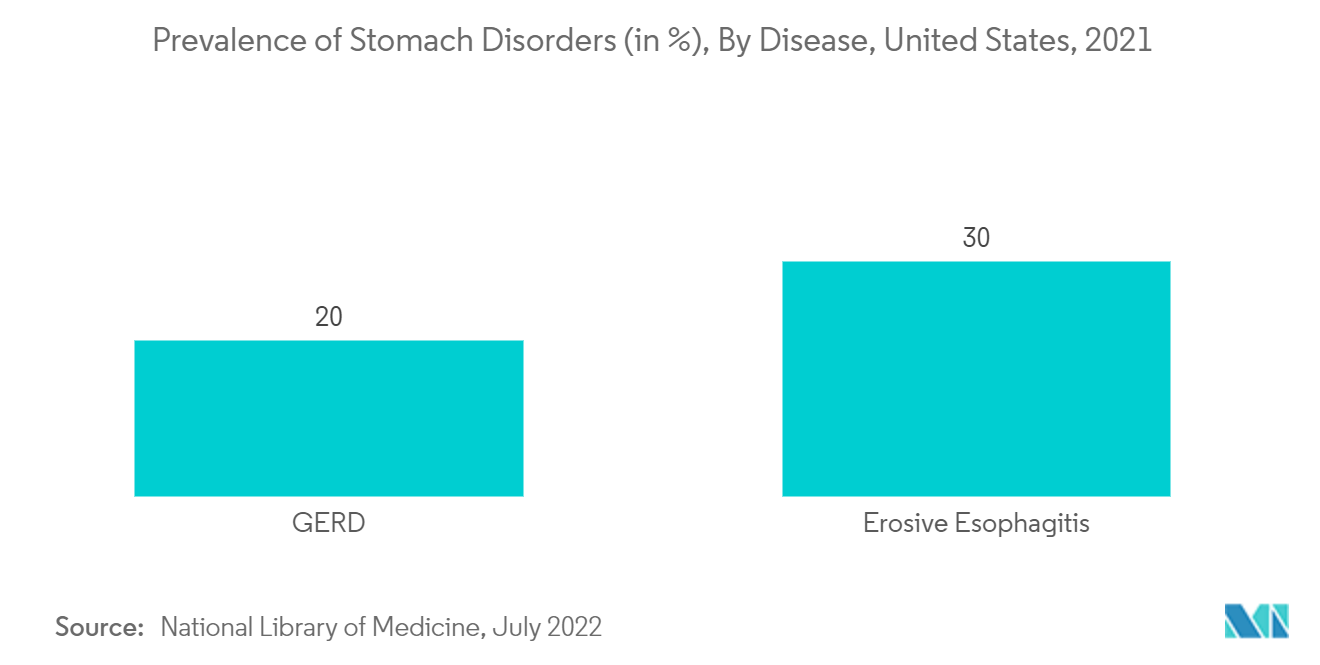
North America is Expected to Hold the Largest Market Share over the Forecast Period
The North America is anticipated to witness growth over the forecast period and dominate the market. Among other countries in the region, the United States is leading the market, due to factors such as an increase in healthcare expenditure, increasing research and developments, and rising prevalence of gastroesophageal reflux disease (GERD). Additionally, the rising geriatric population across the United States is the primary driver for the United States GERD market.
The Nissen fundoplication (laparoscopic Nissen fundoplication) is a surgery to treat GERD. The need for surgery has increased with the increasing prevalence of GERD. In the present era, GERD is a common condition that affects many people globally, while the prevalence is higher in western countries, especially in the United States. An article on Nissen Fundoplication published in the National Library of Medicine in July 2022 mentioned that GERD has the highest prevalence in the United States, ranging from 18.1% to 27.8% of individuals. Such a high burden of the disease in the country is anticipated to demand the availability and development of advanced and effective drugs in the country. Thereby, driving the market growth in the country.
Furthermore, the regional and global players present in the United States are currently focused on the development of advanced drugs and therapeutics for GERD. This is creating numerous competitions among the market players thus, expected to fuel market growth. For instance, in May 2022, Phathom Pharmaceuticals, Inc., a biopharmaceutical company focused on developing and commercializing novel treatments for gastrointestinal diseases received Food and Drug Administration (FDA) acceptance for review of the company’s New Drug Application (NDA) for vonoprazan as a treatment for adults for the healing of all grades of erosive esophagitis (EE) and relief of heartburn and maintenance of healing of all grades of EE and relief of heartburn.
In addition, in January 2022, the generic formulation of Dexilant was released as Dexlansoprazole Delayed Release 30mg and 60mg capsules, manufactured by the company “TWI Pharmaceuticals USA”. Dexlansoprazole is a proton pump inhibitor used to treat heartburn caused by GERD and to heal erosive esophagitis. Such developments in the country are major driving factors of the market studied in the region.
Therefore, owing to the factors mentioned above, the market studied is anticipated to witness growth in the region.
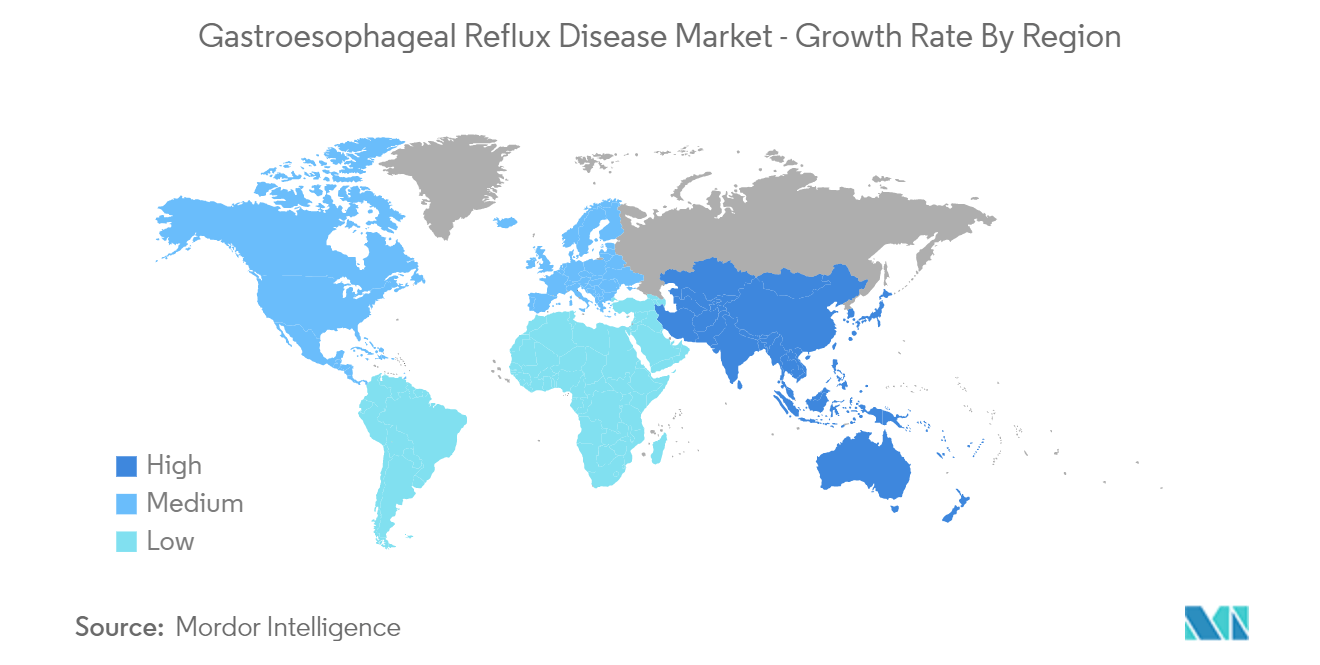
Gastroesophageal Reflux Disease Industry Overview
The market studied is a fragmented market owing to the presence of various market players. Some of the market players are Haleon Group of Companies, SRS Life Sciences, Johnson & Johnson, Medtronic Plc, Pfizer, Inc., Reckitt Benckiser Group Plc, Takeda Pharmaceutical Co., Ltd., Teva Pharmaceuticals Industries Limited., TWi Pharmaceuticals, Inc., AstraZeneca, Zydus Group, Glenmark Pharmaceuticals Ltd, Aurobindo Pharma, among others.
Gastroesophageal Reflux Disease Market Leaders
Pfizer, Inc.
Johnson & Johnson
SRS Life Sciences
Takeda Pharmaceutical Co., Ltd.
Haleon Group of Companies
*Disclaimer: Major Players sorted in no particular order
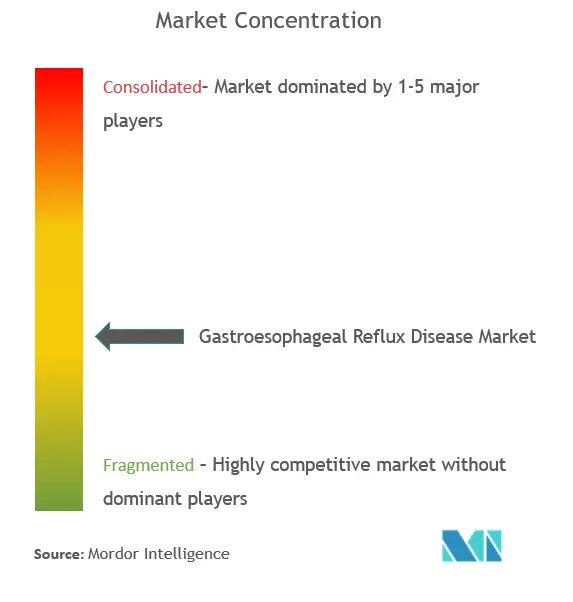
Gastroesophageal Reflux Disease Market News
- In June 2022, Glenmark Pharmaceuticals Ltd acquired the approved generic versions of certain over-the-counter drugs from Wockhardt Ltd in the United States. The acquisition by the company's fully owned subsidiary Glenmark Pharmaceuticals Inc, USA includes the approved abbreviated new drug applications (ANDAs) for famotidine tablets (10 mg and 20 mg) used to treat and prevent ulcers in the stomach and intestine, including indigestion, heartburn, and acid reflux treatment drug Lansoprazole delayed-release capsules USP, 15 mg, among other drugs.
- In June 2022, Famotidine tablets developed by Zydus Lifesciences received Food and Drug Administration (FDA) approval for marketing of Famotidine in the strengths of 20mg and 40mg. Famotidine is a histamine H2 receptor blocker and works by reducing the amount of acid in the stomach. Also, the drug is used to prevent and treat heartburn and other symptoms caused by acid indigestion.
Gastroesophageal Reflux Disease Market Report - Table of Contents
1. INTRODUCTION
1.1 Study Assumptions and Market Definition
1.2 Scope of the Study
2. RESEARCH METHODOLOGY
3. EXECUTIVE SUMMARY
4. MARKET DYNAMICS
4.1 Market Overview
4.2 Market Drivers
4.2.1 Rising Prevalence of Gastrointestinal Reflux Diseases and Changing Lifestyle
4.2.2 Increasing Awareness about GERD
4.3 Market Restraints
4.3.1 Patent Expiry of Blockbuster Drugs
4.3.2 Frequent Product Recalls
4.4 Porter's Five Force Analysis
4.4.1 Threat of New Entrants
4.4.2 Bargaining Power of Buyers/Consumers
4.4.3 Bargaining Power of Suppliers
4.4.4 Threat of Substitute Products
4.4.5 Intensity of Competitive Rivalry
5. MARKET SEGMENTATION
5.1 By Diagnosis
5.1.1 Upper Endoscopy
5.1.2 Ambulatory Acid (pH) Probe Test
5.1.3 Esophageal Manometry
5.1.4 Others
5.2 By Drug Type
5.2.1 Proton Pump Inhibitors (PPIs)
5.2.2 H2 Receptor Blockers
5.2.3 Others
5.3 Geography
5.3.1 North America
5.3.1.1 United States
5.3.1.2 Canada
5.3.1.3 Mexico
5.3.2 Europe
5.3.2.1 Germany
5.3.2.2 United Kingdom
5.3.2.3 France
5.3.2.4 Italy
5.3.2.5 Spain
5.3.2.6 Rest of Europe
5.3.3 Asia Pacific
5.3.3.1 China
5.3.3.2 Japan
5.3.3.3 India
5.3.3.4 Australia
5.3.3.5 South Korea
5.3.3.6 Rest of Asia-Pacific
5.3.4 Middle East and Africa
5.3.4.1 GCC
5.3.4.2 South Africa
5.3.4.3 Rest of Middle East and Africa
5.3.5 South America
5.3.5.1 Brazil
5.3.5.2 Argentina
5.3.5.3 Rest of South America
6. COMPETITIVE LANDSCAPE
6.1 Company Profiles
6.1.1 Haleon Group of Companies
6.1.2 SRS Life Sciences
6.1.3 Johnson & Johnson
6.1.4 Medtronic
6.1.5 Pfizer, Inc.
6.1.6 Reckitt Benckiser Group PLC
6.1.7 Takeda Pharmaceutical Co., Ltd.
6.1.8 Teva Pharmaceuticals Industries Limited.
6.1.9 TWi Pharmaceuticals, Inc.
6.1.10 AstraZeneca
6.1.11 Zydus Group
6.1.12 Glenmark
6.1.13 Aurobindo Pharma
- *List Not Exhaustive
7. MARKET OPPORTUNITIES AND FUTURE TRENDS
Gastroesophageal Reflux Disease Industry Segmentation
As per the scope of this report, gastroesophageal reflux disease (GERD) is a disorder in which the lower oesophageal sphincter is affected and causes the backflow of contents from the stomach to the oesophagus. The major causes of gastroesophageal reflux disease include obesity, smoking, and sedentary lifestyle habits.
The gastroesophageal reflux disease market is segmented by Diagnosis (Upper Endoscopy, Ambulatory Acid (pH) Probe Test. Esophageal Manometry and Others), Drug Type (Proton Pump Inhibitors (PPIs), H2 Receptor Blockers, and Others), and Geography (North America, Europe, Asia-Pacific, Middle East and Africa, and South America). The market report also covers the estimated market sizes and trends for 17 different countries across major regions, globally. The report offers the value (in USD million) for the above segments.
| By Diagnosis | |
| Upper Endoscopy | |
| Ambulatory Acid (pH) Probe Test | |
| Esophageal Manometry | |
| Others |
| By Drug Type | |
| Proton Pump Inhibitors (PPIs) | |
| H2 Receptor Blockers | |
| Others |
| Geography | ||||||||
| ||||||||
| ||||||||
| ||||||||
| ||||||||
|
Gastroesophageal Reflux Disease Market Research FAQs
What is the current Global Gastroesophageal Reflux Disease Market size?
The Global Gastroesophageal Reflux Disease Market is projected to register a CAGR of 4.3% during the forecast period (2023-2028).
Who are the key players in Global Gastroesophageal Reflux Disease Market?
Pfizer, Inc., Johnson & Johnson, SRS Life Sciences, Takeda Pharmaceutical Co., Ltd. and Haleon Group of Companies are the major companies operating in the Global Gastroesophageal Reflux Disease Market.
Which is the fastest growing region in Global Gastroesophageal Reflux Disease Market?
Asia Pacific is estimated to grow at the highest CAGR over the forecast period (2023-2028).
Which region has the biggest share in Global Gastroesophageal Reflux Disease Market?
In 2023, the North America accounts for the largest market share in the Global Gastroesophageal Reflux Disease Market.
Global Gastroesophageal Reflux Disease Industry Report
Statistics for the 2023 Global Gastroesophageal Reflux Disease market share, size and revenue growth rate, created by Mordor Intelligence™ Industry Reports. Global Gastroesophageal Reflux Disease analysis includes a market forecast outlook to 2028 and historical overview. Get a sample of this industry analysis as a free report PDF download.
